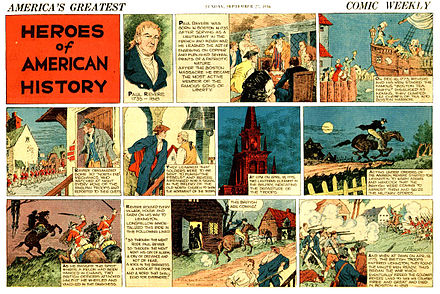- Non-fiction comics
-
 Paul Revere was profiled in this King Features comic strip (September 27, 1936).
Paul Revere was profiled in this King Features comic strip (September 27, 1936).
Non-fiction comics, also known as graphic non-fiction, is non-fiction in the comics medium, embracing a variety of formats from comic strips to trade paperbacks.
Contents
Comic strips and comic books
Traditionally, comic strips have long offered factual material in this category, notably Ripley's Believe It or Not!, along with Ralph Graczak's Our Own Oddities and King Features' Heroes of American History and others. Dick's Adventures in Dreamland was another attempt by King Features to teach history with comics. Clayton Knight created a strip about aviators, The Hall of Fame of the Air (1935-40), later collected in a book. Texas History Movies, which began on October 5, 1926, in The Dallas Morning News, received praise from educators, as did America's Best Buy: The Louisiana Purchase, a 1953 daily strip in the New Orleans States, distributed nationally by the Register and Tribune Syndicate (which also handled Will Eisner's The Spirit supplement for Sunday newspapers.[1][2]
Non-fiction was published in numerous comic books, notably Picture News, True Comics and Heroic Comics. A notable scripter of this material for 1940s comic books was novelist Patricia Highsmith, who wrote for Real Fact, Real Heroes and True Comics.[3]
Books
Francisca Goldsmith, writing in the School Library Journal in 2008, assembled a "list of essential titles for high schoolers" and reviewed graphic nonfiction by a variety of creators, including Rick Geary (Treasury of Victorian Murder), Harvey Pekar (Students for a Democratic Society), Stan Mack (The Story of the Jews), Joe Sacco (Palestine), Marjane Satrapi (Persepolis), Osamu Tezuka (Buddha) and Howard Zinn (A People’s History of American Empire).[4]
Larry Gonick (The Cartoon History of the Universe) produced graphic non-fiction about science and history for more than 30 years. Other examples are The 9/11 Report: A Graphic Adaptation and After 9/11: America’s War on Terror, both by Sid Jacobson and Ernie Colón.[4] Hill & Wang, which published the 9/11 books, has published several other works of graphic non-fiction.
In A.D.: New Orleans After the Deluge (2009), Josh Neufeld documented true stories of survival during Hurricane Katrina as witnessed by the survivors: Denise, a counselor, social worker and sixth-generation New Orleanian; friends Abbas and Darnell, who await the storm in Abbas’s family-run market; pastor's son Kwame, entering his senior year of high school; and the young couple Leo and Michelle, who both grew up in New Orleans. Each confronts the same decision–stay or flee.[5]
References
- ^ Markstein, Don. Toonopedia: Dick's Adventures in Dreamland
- ^ The Hall of Fame of the Air.
- ^ The Talented Miss Highsmith: The Secret Life and Serious Art of Patricia Highsmith, by Joan Schenkar, 2009; ISBN# 978-0-312-30375-4
- ^ a b School Library Journal, November 1, 2008.
- ^ Smith: Josh Neufeld
See also
External links
Categories:- Non-fiction graphic novels
- Non-fiction comics
Wikimedia Foundation. 2010.
